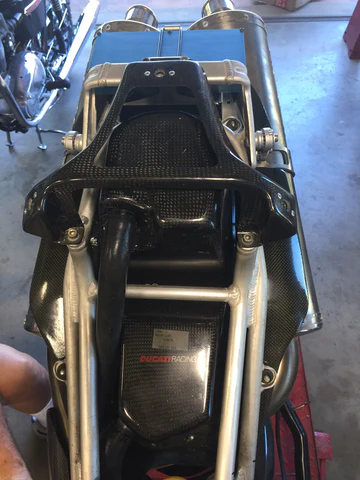2001 Reve RedBull Ducati 996 rs/2002 IFC Ducati 996 rs
Posted by Scot Wilson on Jan 12th 2017
One of our projects that will soon be completed and ready for sale is one of the Reve RedBull Ducati 996rs that was ridden by John Reynolds to his championship win in the 2001 season of British Superbike. As I have paperwork from team management, the history of this racebike does not end with the Reve RedBull team but it was also
 was also campaigned in the 2002 season of British Superbike by Sean Emmett when he was the number 1 rider for team IFC Ducati. Above is a photo from the 2001 season when John Reynolds and Sean Emmett were teammates with Reve RedBull.
was also campaigned in the 2002 season of British Superbike by Sean Emmett when he was the number 1 rider for team IFC Ducati. Above is a photo from the 2001 season when John Reynolds and Sean Emmett were teammates with Reve RedBull.
As mentioned before, after John Reynolds won the British Superbike series in 2001, he elected to move to a different team. Sean Emmett became the #1 rider for IFC Ducati in the 2002 season of British Superbike. The IFC Ducati 996 rs was very competitive even against the Ducati 998 RS ridden by Steve Hislop. Sean and Hizzy traded paint off of their side panels throughout the season until IFC ran out of money midway through the 2002 season and had to fold. Featured is a photo that I purchased with Sean on his Ducati 996 rs leading Hizzy on his Ducati 998 rs. Hizzy did end up winning that season but it was a hard fought battle and a great DVD to watch of that 2002 season.
 Building up a Ducati Superbike is not any easy task or an inexpensive one as each team had their own "recipe" with regard to set-up and configuration to maximize the performance and the feel of the bike to each racer's specifications. The more comfortable the rider, the more successful he would be at the track.
Building up a Ducati Superbike is not any easy task or an inexpensive one as each team had their own "recipe" with regard to set-up and configuration to maximize the performance and the feel of the bike to each racer's specifications. The more comfortable the rider, the more successful he would be at the track.
I find that I love the colour scheme of the Reve RedBull Ducati and elected to paint this race bike in that format. I do have a set of the 996 rs side panels in IFC Ducati white and there is blue "over-spray" on the inside of these panels from when they were Reve RedBull panels. The bodywork was fiberglass and manufactured by one of the team sponsors, FibreOne Tech. The bodywork is all fiberglass but the RS fuel tank is Ducati Corse carbon fiber as well as the very large Corse RS airbox and the Corse RS engine case breather tank.
 The blue box at the end of the subframe that holds the 60 mm Micron Exhaust system that John Reynolds, I am told, preferred with the Ducati Corse triple-fuel injection system is the Lamda controller. This system aided the team to get the engine mapped to its optimal performance levels for each race venue.
The blue box at the end of the subframe that holds the 60 mm Micron Exhaust system that John Reynolds, I am told, preferred with the Ducati Corse triple-fuel injection system is the Lamda controller. This system aided the team to get the engine mapped to its optimal performance levels for each race venue.
These Superbikes only resembled their street-bike counterparts in looks only if we are being honest. The data input and feedback from on-board systems as well as the adjustability of the mapping of the engine, the adjustability of the suspension and the brakes make these purpose build racing machines only. A telemetry system is also a part of this racebike that provides the team and rider with valuable suspension travel data so that it can be customized to the challenges of each specific race track. The technology is arguably, fascinating. Yet not practical as I was able to take my other 996 rs in first gear up to 75 mph before having to shift due to the gearing of the Corse close ratio gearbox and without over-reving the engine.
The frame number for this authenticated machine is VS-34-00-30461A-17/03/00. As a true Ducati Corse item, it is purpose built to take what I have been told was the largest airbox that Ducati ever used as it is indeed, massive and the airbox extends all the way to the front steering tube. The Corse frame also allows for the swingarm to be easily and quickly removed as it pulls directly out. On my 996 S streetbike, the street swingarm must be "looped" over the engine and the frame pulled down to get everything to fit securely. I am sure that there are race engineers at Ducati Corse and Verlicchi who could talk more in depth as to the other significant advantages of a Corse frame, other than lightness and strength.
I will continue to discuss different and unique aspects of this racing machine in future blogs. Thank you for your interests.
